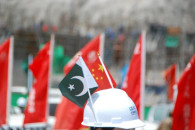Employment opportunities: Political instability and corruption biggest obstacles
World Bank report criticises Pakistan for abandoning reforms.

Employment opportunities: Political instability and corruption biggest obstacles
The World Bank said on Friday that political instability, corruption and uncertainty in government policies were the most binding constraints for Pakistani business firms in expanding and creating jobs for an ever-increasing young population.
In its flagship report titled, “More and Better Jobs in South Asia,” the World Bank used enterprise surveys to know the ability of businesses to expand and create employment in South Asia where 350 million people will enter the job market over the next two decades.
Enterprise surveys ask firms to rate the severity of inadequacies in various elements of the business environment for their ability to operate and expand.
The biggest constraints for the expanding manufacturing firms in Pakistan are political instability and corruption, the report said. It rated uncertainty in government policy as the third biggest obstacle followed by a poor tax administration and macro-instability.
However, for the benchmark firm - defined as a medium-sized manufacturing firm with 30 employees, which is domestically owned, does not export or import, is located in a large city, and did not expand employment in preceding three years - corruption is not a concern, the report said.
The biggest worry for the benchmark firm is a poor tax administration followed by non-availability of electricity, it said. Non-expanding firms have rated political instability and uncertainty in government policies as third and fourth biggest hurdles in their expansion plans. They see ineffective courts as the fifth biggest issue for them.
The report said Pakistan, where economic growth had been volatile in the past, and Nepal, where growth had been low and stagnant, were yet to see a demographic dividend. With better policies, their growth performance can improve in the future, as the demographic transition takes hold, it added.
Overall, the three most binding constraints for medium-sized urban formal firms in South Asia
are electricity, corruption and political instability,
the report said.
It said the South Asia region would need to add between one and 1.2 million additional jobs every month for the next 20 years, equivalent to about 40 per cent of the increase in the global labour force. Reforms will have to be accelerated if the region is going to meet the challenge of creating better jobs, it said.
Contrary to that, the report said, Pakistan has recently left the reforms path, which it was implementing half-heartedly. Economic managers have decided to abandon the IMF programme at a time when chances of taking imprudent fiscal decisions are higher due to forthcoming elections, it said. The government has remained unable to reform the electricity sector, which the firms have rated as one of the biggest five concerns.
According to an official handout, released by the World Bank’s resident office in Pakistan, the key asset to South Asia is its people. South Asia has a young population and the second lowest female participation rate in the labour force, it said.
“The demographic transition will result in more than 350 million people entering the working-age population over the next two decades,” World Bank South Asia Vice President Isabel Guerrero said. “Creating jobs for them will contribute to growth, equity and peace in the region.”
South Asia created nearly 800,000 jobs per month between 2000 and 2010. However, the region is still home to the largest number of the world’s poor - half a billion people.
Since labour is the primary asset of the poor, having more and better jobs is the key employment challenge facing the region, the report said.
“The number of additions to the labour market over the next few decades will result in a 25-50 per cent increase over the historical average,” said Pablo Gottret, co-author of the report. “Going forward, the region faces an enormous employment challenge, but its demography can help if countries choose to reform.”
Published in The Express Tribune, September 24th, 2011.

















COMMENTS
Comments are moderated and generally will be posted if they are on-topic and not abusive.
For more information, please see our Comments FAQ